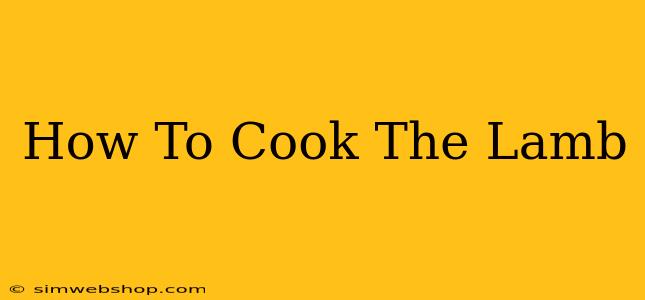Lamb, with its rich flavor and tender texture, is a culinary delight. However, cooking lamb can be intimidating for some, leading to overcooked, dry meat. This comprehensive guide will walk you through various methods of cooking lamb, ensuring you achieve succulent and flavorful results every time. We'll cover everything from choosing the right cut to mastering different cooking techniques.
Choosing Your Lamb Cut: A Crucial First Step
The success of your lamb dish hinges on selecting the right cut. Different cuts are best suited for different cooking methods. Consider these popular options:
- Leg of Lamb: A classic choice, perfect for roasting. It yields tender, flavorful meat when cooked properly. Look for a leg with good marbling for optimal juiciness.
- Rack of Lamb: Ideal for special occasions, rack of lamb boasts impressive presentation and delicious, tender chops. Choose a rack with evenly spaced ribs for even cooking.
- Lamb Shoulder: A tougher cut, but incredibly flavorful when slow-cooked. Braising or slow roasting are best for lamb shoulder, resulting in melt-in-your-mouth tenderness.
- Lamb Chops: Quick-cooking and elegant, lamb chops are perfect for grilling, pan-frying, or broiling. Look for chops that are evenly thick for consistent cooking.
- Lamb Stew Meat: As the name suggests, this is best used for stews and casseroles. Its toughness breaks down beautifully during long, slow cooking.
Mastering Different Cooking Methods for Lamb
Now that you've chosen your cut, let's explore popular cooking methods:
Roasting Lamb: Achieving Perfection
Roasting is the quintessential way to cook a leg of lamb or a rack. Here's how:
- Preheat your oven: To a temperature between 325°F (160°C) and 350°F (175°C).
- Season generously: Use salt, pepper, garlic powder, rosemary, and thyme.
- Sear (optional): Searing the lamb before roasting creates a beautiful crust.
- Roast: Roast according to the weight and desired doneness. Use a meat thermometer for accuracy. A good rule of thumb is 135°F (57°C) for medium-rare.
- Rest: Allow the lamb to rest for at least 15-20 minutes before carving. This allows the juices to redistribute, resulting in a more tender and flavorful final product.
Pan-Searing and Grilling Lamb: Quick and Delicious
For lamb chops or smaller cuts, pan-searing or grilling delivers quick, delicious results:
- Prepare the lamb: Season generously.
- Heat your pan or grill: Use high heat for a good sear.
- Sear: Sear the lamb for 2-3 minutes per side to achieve a beautiful crust.
- Cook to desired doneness: Continue cooking, reducing heat if necessary, until the internal temperature reaches your desired doneness.
- Rest: Allow to rest before serving.
Slow Cooking Lamb: Unlocking Tenderness
Lamb shoulder benefits greatly from slow cooking:
- Brown the lamb: Brown the lamb on all sides in a large pot or Dutch oven.
- Add aromatics: Add onions, garlic, carrots, and herbs.
- Simmer: Add liquid (broth, wine, or water) and simmer until the lamb is fork-tender, typically 6-8 hours.
- Shred (optional): Shred the lamb before serving.
Achieving the Perfect Doneness: Using a Meat Thermometer
Using a meat thermometer is crucial for cooking lamb to your desired doneness. Here’s a guide to internal temperatures:
- Rare: 125°F (52°C)
- Medium-Rare: 135°F (57°C)
- Medium: 145°F (63°C)
- Well-Done: 160°F (71°C)
Tips for Cooking Delicious Lamb
- Marinate: Marinating the lamb enhances flavor and tenderness.
- Let it rest: Always allow the lamb to rest before carving.
- Use a meat thermometer: This is the best way to ensure your lamb is cooked perfectly.
- Don't overcook: Overcooked lamb is dry and tough.
By following these tips and techniques, you can confidently cook delicious, perfectly tender lamb every time, impressing your friends and family with your culinary skills. Now go forth and conquer the world of lamb cooking!

